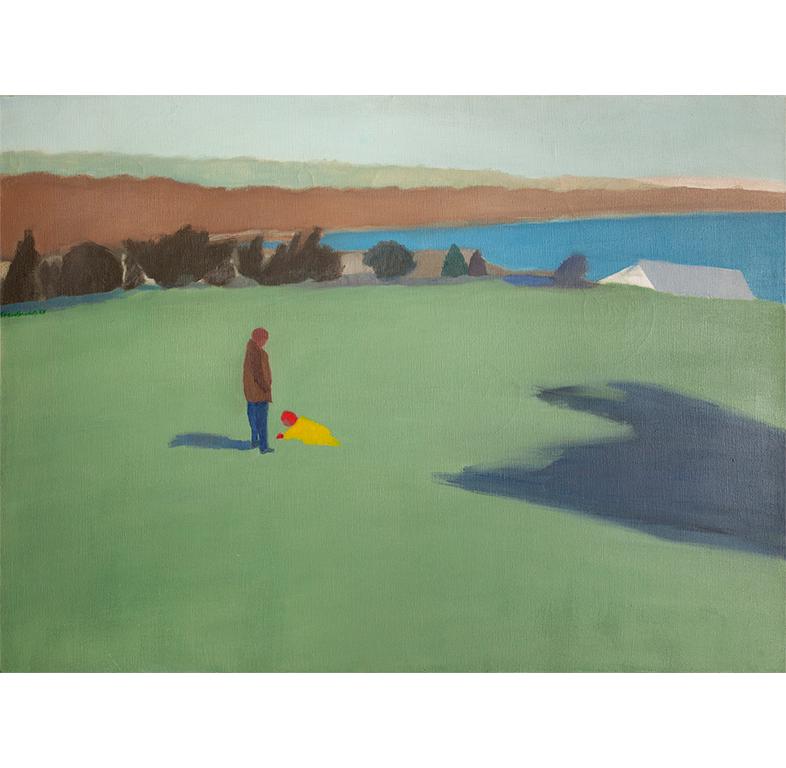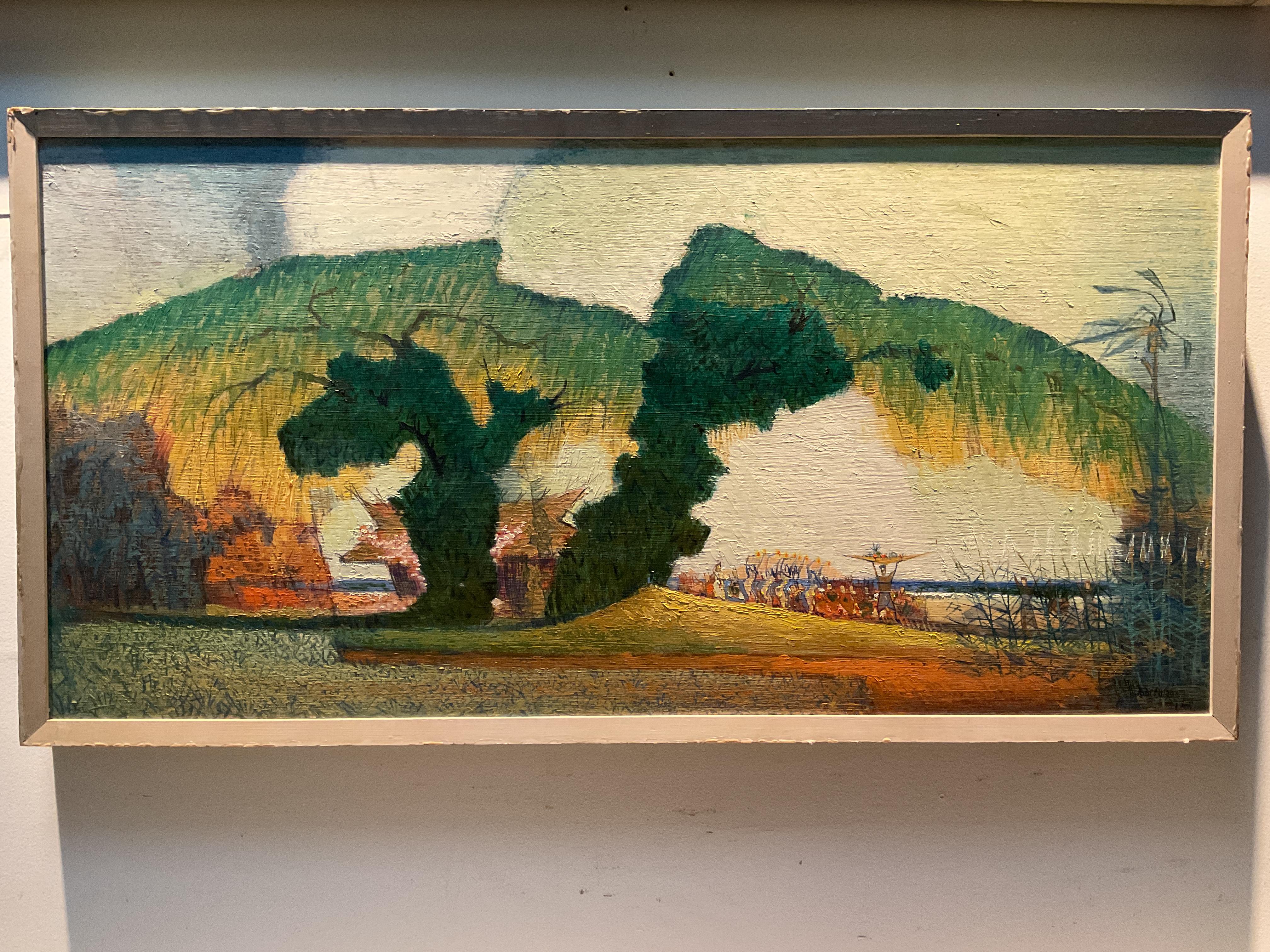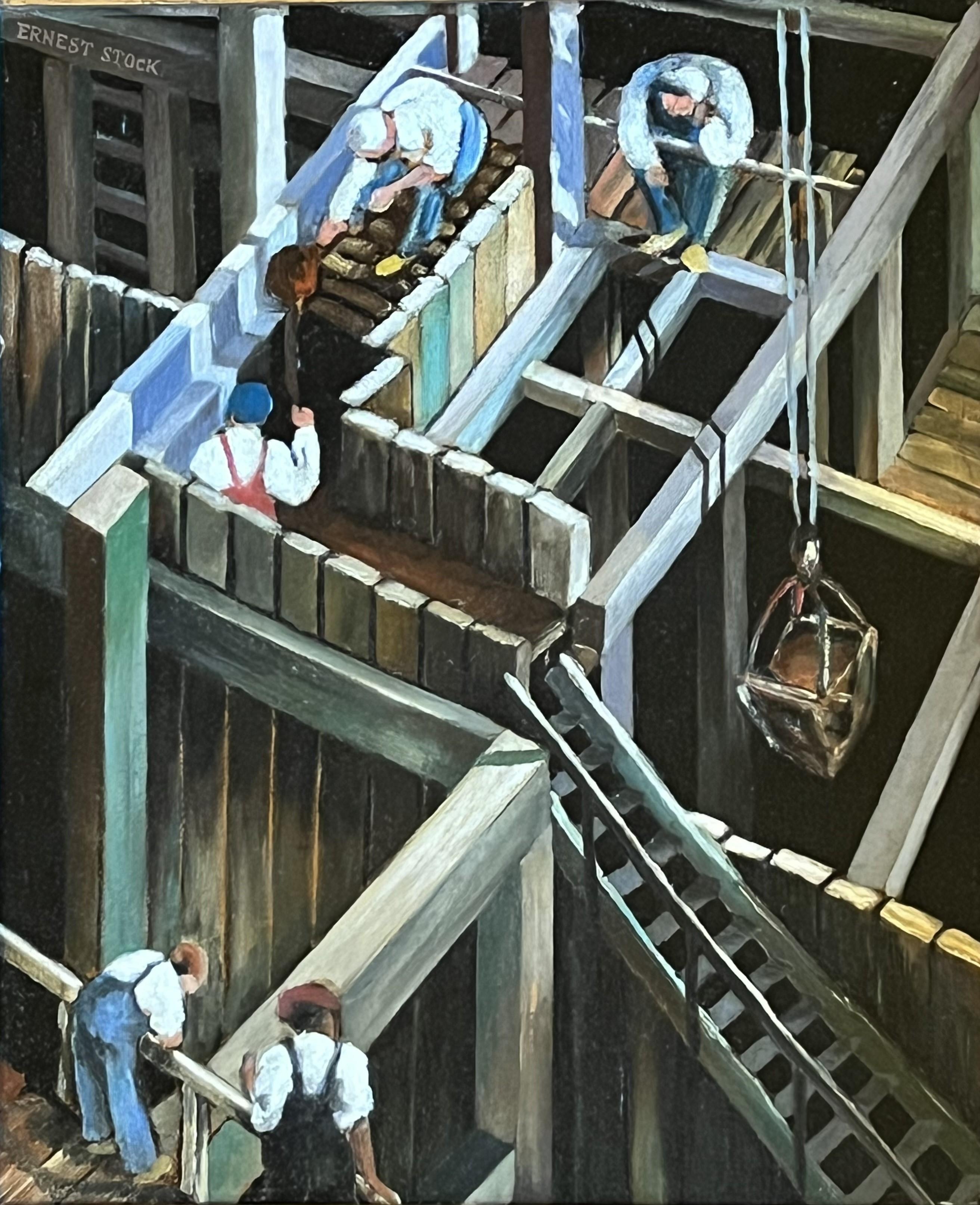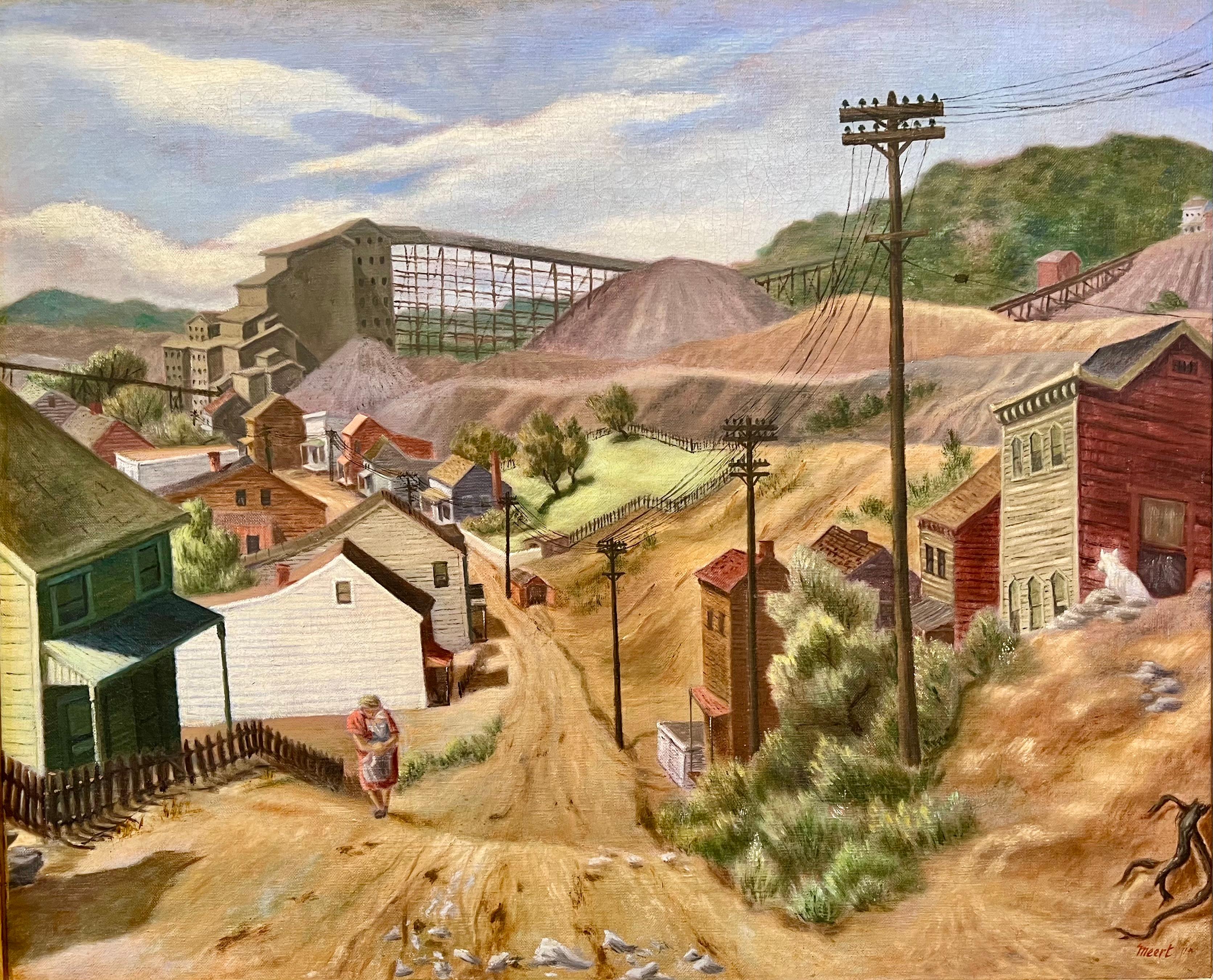Items Similar to Casting Call
Want more images or videos?
Request additional images or videos from the seller
1 of 8
David FeBlandCasting Call2023
2023
About the Item
Febland creates wonderfully dynamic technical and dramatic narratives. The works are evocative of many places in America(especially that of his newer works which seem to sew-together many places in the Southwest United States). His recent move to AZ his clearly been a fertile discovery for him and has made an honest and original depiction of it. Not it's Desert vistas and canyons, but it's paint faded inner cities, and cracked blacktop. The many underlying themes reveal themselves the more work is studied.
- Creator:
- Creation Year:2023
- Dimensions:Height: 34 in (86.36 cm)Width: 42.25 in (107.32 cm)
- More Editions & Sizes:34 x 42.25 inches Price: $11,200
- Medium:
- Movement & Style:
- Period:
- Condition:
- Gallery Location:Scottsdale, AZ
- Reference Number:1stDibs: LU1246112607042
About the Seller
5.0
Vetted Seller
These experienced sellers undergo a comprehensive evaluation by our team of in-house experts.
Established in 1992
1stDibs seller since 2019
14 sales on 1stDibs
Typical response time: Several days
- ShippingRetrieving quote...Ships From: Scottsdale, AZ
- Return PolicyThis item cannot be returned.
More From This SellerView All
- Still/LifeBy David FeBlandLocated in Scottsdale, AZDavid Febland is a prominent American artist working today. He pulls together imagery from his travels and composes them in a scene that is full of movement. The work is imbued wit...Category
2010s American Modern Figurative Paintings
MaterialsOil
- HomebodyBy David FeBlandLocated in Scottsdale, AZFebland creates wonderfully dynamic technical and dramatic narratives. The works are evocative of many places in America(especially that of his newer works which seem to sew-togethe...Category
2010s American Modern Landscape Paintings
MaterialsOil
- MonasteryLocated in Scottsdale, AZVladimir Skryabin was an innovative painter who lived in Leningrad/St. Petersburg during the 20th century. He was classically trained as a painter and graphic artists and his painti...Category
1960s Impressionist Landscape Paintings
MaterialsOil
- Do Not DisturbBy Alina SharovskayaLocated in Scottsdale, AZ"Do Not Disturb" by Ukrainian painter, Alina Sharovskaya, depicts a peaceful moment of rest in her life in which there is momentary peace. It is a self-portrait of sorts.Category
2010s Contemporary Landscape Paintings
MaterialsOil
- Warm HouseBy Alina SharovskayaLocated in Scottsdale, AZThis small painting depicts the artist's personal journey in being uprooted from her home in Ukraine to the UK--in search of a warm home.Category
2010s Contemporary Landscape Paintings
MaterialsOil
- Happy FeetLocated in Scottsdale, AZ"Happy Feet," is by an up and coming Moldovan painter named Stefan Mocanu. Stefan, lives painting. He finds the incredible in the everyday and transforms it into a pictorial joy. ...Category
2010s Contemporary Figurative Paintings
MaterialsOil
You May Also Like
- Southdown Field at Long Island Sound Beach Parent and childBy Stan BrodskyLocated in Brookville, NYThis large green field overlooking the Long Island Sound Beach depicts a parent without definition, mother or father, observing their child in the gr...Category
1960s American Modern Figurative Paintings
MaterialsOil
- FRANKLIN Karl Mann Associates NY - Oil o/B - Brooklyn Bridge & Manhattan SkylineLocated in Meinisberg, CHFranklin for KARL MANN ASSOCIATES, New York (American, active in the 1960 's) The boarded up Brooklyn Bridge and the Manhattan Skyline - Oil on ...Category
1960s American Modern Landscape Paintings
MaterialsBoard, Oil
- Stylish Hawaiian Luau Oil Painting by Listed artist Mario Larrinaga (1895-1979)Located in Baltimore, MDMario Larrinaga was born in Baja California in 1895 and moved with his brother to Los Angeles in 1909. He had no formal training in art, but had natural talent that was noticed by local movie studios. He was hired by Universal Studios as a designer, art director and creator of background scenes. He produced some of the background effects for King Kong in 1933. After a career in set design and illustration he focused on painting for pleasure in California, Mexico and Hawaii. He belonged to local art clubs and exhibited his works often. This stylized modernist work was likely created around 1960. It is oil on wood panel and of a horizontal format, 18” x 36”. It portrays a procession of seemingly Hawaiian natives...Category
Mid-20th Century American Modern Figurative Paintings
MaterialsOil
- Six O'ClockLocated in Los Angeles, CASix O-Clock, c. 1942, oil on canvas, 30 x 20 inches, signed and titled several times verso of frame and stretcher (perhaps by another hand), marked “Rehn” several times on frame (for the Frank K. M. Rehn Galleries in New York City, who represented Craig at the time); Exhibited: 1) 18th Biennial Exhibition of Contemporary American Oil Paintings from March 21 to May 2, 1943 at The Corcoran Gallery of Art in Washington, D.C. #87, original price $450 (per catalog) (exhibition label verso), 2) Craig’s one-man show at the Frank K. M. Rehn Galleries, New York City, from October 26 to November 14, 1942, #10 (original price listed as $350); and 3) Exhibition of thirty paintings sponsored by the Harrisburg Art Association at the State Museum of Pennsylvania in Harrisburg in March, 1944 (concerning this exhibit, Penelope Redd of The Evening News (Harrisburg, Pennsylvania) wrote: “Other paintings that have overtones of superrealism inherent in the subjects include Tom Craig’s California nocturne, ‘Six O’Clock,’ two figures moving through the twilight . . . .” March 6, 1944, p. 13); another label verso from The Museum of Art of Toledo (Ohio): original frame: Provenance includes George Stern Gallery, Los Angeles, CA About the Painting Long before Chris Burden’s iconic installation outside of the Los Angeles County Museum of Art, Urban Light, another artist, Tom Craig, made Southern California streetlights the subject of one of his early 1940s paintings. Consisting of dozens of recycled streetlights from the 1920s and 1930s forming a classical colonnade at the museum’s entrance, Burden’s Urban Light has become a symbol of Los Angeles. For Burden, the streetlights represent what constitutes an advanced society, something “safe after dark and beautiful to behold.” It seems that Craig is playing on the same theme in Six O-Clock. Although we see two hunched figures trudging along the sidewalk at the end of a long day, the real stars of this painting are the streetlights which brighten the twilight and silhouette another iconic symbol of Los Angeles, the palm trees in the distance. Mountains in the background and the distant view of a suburban neighborhood join the streetlights and palm trees as classic subject matter for a California Scene painting, but Craig gives us a twist by depicting the scene not as a sun-drenched natural expanse. Rather, Craig uses thin layers of oil paint, mimicking the watercolor technique for which he is most famous, to show us the twinkling beauty of manmade light and the safety it affords. Although Southern California is a land of natural wonders, the interventions of humanity are already everywhere in Los Angeles and as one critic noted, the resulting painting has an air of “superrealism.” About the Artist Thomas Theodore Craig was a well-known fixture in the Southern California art scene. He was born in Upland California. Craig graduated with a degree in botany from Pomona College and studied painting at Pamona and the Chouinard Art School with Stanton MacDonald-Wright and Barse Miller among others. He became close friends with fellow artist Milford Zornes...Category
1940s American Modern Landscape Paintings
MaterialsCanvas, Oil
- Subway ConstructionLocated in Los Angeles, CAThis painting is part of our exhibition American Coast to Coast: Artists of the 1930s Subway Construction, c. 1928, oil on board, 19 x 15 ¾ inches, signed upper left, artist and title verso; exhibited: 1) 12th Annual Exhibition of the Society of Independent Artists, The Waldorf Astoria, New York NY, from March 9 to April 1, 1928, no. 864 (original price $250) (see Death Prevailing Theme of Artists in Weird Exhibits, The Gazette (Montreal, Quebec, Canada), March 8, 1928); 2) Boston Tercentenary Exhibition Fine Arts and Crafts Exhibition, Horticultural Hall, Boston MA, July, 1930, no. 108 (honorable mention - noted verso); 3) 38th Annual Exhibition of American Art, Cincinnati Art Museum, Cincinnati, OH, June, 1931 (see Alexander, Mary, The Week in Art Circles, The Cincinnati Enquirer, June 7, 1931); and 4) National Art Week Exhibition [Group Show], Montross Gallery, New York, New York, December, 1940 (see Devree, Howard, Brief Comment on Some Recently Opened Exhibitions in the Galleries, The New York Times, December 1, 1940) About the Painting Ernest Stock’s Subway Construction depicts the excavation of New York’s 8th Avenue line, which was the first completed section of the city-operated Independent Subway System (IND). The groundbreaking ceremony was in 1925, but the line did not open until 1932, placing Stock’s painting in the middle of the construction effort. The 8th Avenue line was primarily constructed using the “cut and cover” method in which the streets above the line were dug up, infrastructure was built from the surface level down, the resulting holes were filled, and the streets reconstructed. While many artists of the 1920s were fascinated with the upward thrust of New York’s exploding skyline as architects and developers sought to erect ever higher buildings, Stock turned his attention to the engineering marvels which were taking place below ground. In Subway Construction, Stock depicts workers removing the earth beneath the street and building scaffolding and other support structures to allow concrete to be poured. Light and shadow fall across the x-shaped grid pattern formed by the wooden beams and planks. It is no surprise that critics reviewing the painting commented on Stock’s use of an “interesting pattern” to form a painting that is “clever and well designed.” About the Artist Ernest Richard Stock was an award-winning painter, print maker, muralist, and commercial artist. He was born in Bristol, England and was educated at the prestigious Bristol Grammar School. During World War I, Stock joined the British Royal Air Flying Corps in Canada and served in France as a pilot where he was wounded. After the war, he immigrated to the United States and joined the firm of Mack, Jenny, and Tyler, where he further honed his architectural and decorative painting skills. During the 1920s, Stock often traveled back and forth between the US and Europe. He was twice married, including to the American author, Katherine Anne Porter. Starting in the mid-1920s, Stock began to exhibit his artwork professionally, including at London’s Beaux Arts Gallery, the Society of Independent Artists, the Salons of America, the Cincinnati Art Museum, the Whitney Studio and various locations in the Northeast. Critics often praised the strong design sensibility in Stock’s paintings. Stock was a commercial illustrator for a handful of published books and during World War II, he worked in the Stratford Connecticut...Category
1920s American Modern Figurative Paintings
MaterialsOil
- Gold Mine, Central City, ColoradoBy Joseph MeertLocated in Los Angeles, CAThis painting is part of our exhibition America Coast to Coast: Artists of the 1930s Goldmine, Central City, Colorado, oil on canvas, 36 x 28 inches, c. 1936, signed lower right, ex collection of Platt Fine Art, Chicago, Illinois (label verso). About the Painting Joseph Meert’s painting, Goldmine, Central City, Colorado, depicts the short-lived resurrection of a once prominent city just outside Denver. Central City was founded in 1859 soon after John Gregory struck gold in the area. As word spread, thousands of miners converged into “Gregory’s Gulch” and its surroundings became known as the “richest square mile on earth.” Mining production quickly increased resulting in Central City to becoming Colorado’s largest city in the early 1860s. Despite some technical difficulties transitioning to lode mining and the rise of competition from Leadville, Central City remained an economic boom town through the turn of the century. But, with every boom, there is a bust. World War I marked the end of Central City’s prominence as ore production ground to a halt and by 1925, the town’s population shrank to only 400 people. The desperation of the Great Depression and a nearly 100% increase in the price of gold lured labor and capital back to Central City. Meert painted in Colorado during the mid-1930s, a time when he created his most desirable works. It is during this period of renaissance that Meert captures one of Central City's outlying dirt streets bordered by 19th century wooden houses from the town's heyday and the more recently installed electric lines leading to a distant gold mine. A lone figure trudges up the hill, a mother with a baby in her arms, putting us in mind of the rebirth of the town itself. Meert had solo exhibitions at the Colorado Springs Fine Arts Center in 1936 and the Denver Art Museum. Although it is not known whether Goldmine, Central City was included in either of these exhibitions, it seems likely. Moreover, the painting is closely related to Meert’s painting, The Old Road, which was painted in 1936 and exhibited at the Corcoran Gallery of Art in Washington, DC and at the Dallas Museum of Art. About the Artist Joseph Meert was a well-regarded painter and muralist, who initially made a name for himself in the American Scene and later as an abstract expressionist. Although initially successful, Meert struggled financially and with mental illness later in life. He was born in Brussels, Belgium, but moved with his family to Kansas City, Missouri. As a child, a chance encounter at the Union Pacific Railyard changed his life. Meert happened upon a worker repainting and stenciling a design on a railroad car. Meert later recalled that this experience introduced him to the idea of being a painter. Without support from his father, Meert obtained a working scholarship to the Kansas City Art Institute. After four years at the Kansas City Art Institute, Meert studied seven years at the Art Students League and in Europe and Los Angeles. At the Art Students League, Meert fell under the spell of Thomas Hart Benton and Stanton MacDonald-Wright. In 1931, he befriended Jackson Pollock. By 1934, Meert was part of the Public Works of Art Project when he met his wife, Margaret Mullin...Category
1930s American Modern Landscape Paintings
MaterialsCanvas, Oil





